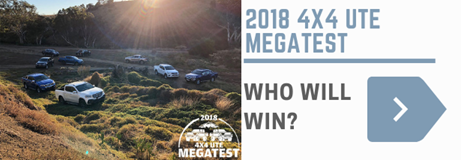After a few false starts, Ssangyong is ready to have a serious crack at the Australian market with vehicles like its all-new Musso ute. Fraser Stronach reports
Ssangyong, which stated as Ha Dong-Hwan Motors in 1954 in South Korea, has had somewhat of a confusing history here in Australia. Ssangyong first appeared in 1996 when its Musso 4×4 wagon was sold via Mercedes-Benz dealers. That was off the back of a resource-sharing arrangement that Ssangyong and Benz had at the time.
Shortly after that Ssangyong sales migrated to Daewoo dealers after the fellow South-Korean automaker purchased a controlling interest in Ssangyong in 1997. After Daewoo closed its doors a few years later, Ssangyong models were imported into Australia via third-party distributors, although that ceased a few years back.
But all that’s history now as Ssangyong has, as of last year, set up a factory owned and backed distributor here in Australia, which should bring on-going stability to the brand.
Ssangyong is introducing a number of new models, the Musso 4wd dual-cab ute being the first cab off the rank.
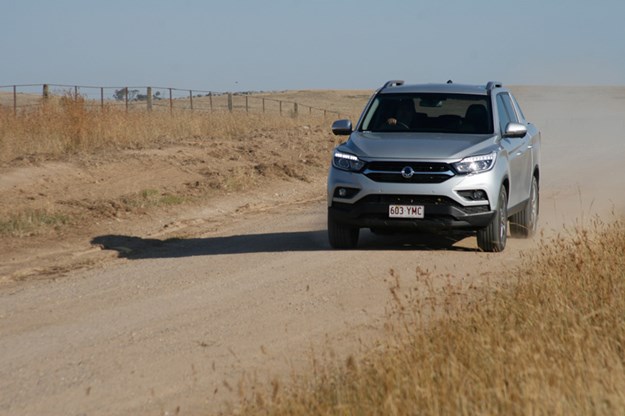 |
Climb aboard
Our test vehicle is a top-spec Ultimate, which means you’re greeted with the luxury of leather, and even a sunroof, which is extremely unusual for a ute as it’s only offered among the popular utes on the Nissan Navara ST-X, and then only as an option. No sidesteps or assist handle to help you climb on board however, although the Musso isn’t as high-riding as some utes, so the step-up is not notably tall.
Once inside you’ll find the Musso’s cabin has more of a car-like feel – complete with push-button start – than anything resembling a commercial vehicle and is well appointed and finished. The cabin’s also notably wide and spacious up front and the driver has the relative luxury (in the ute world anyway) of both tilt and reach steering wheel adjustment. Comfortable front seats too.
In the rear seat there’s good shoulder room but the leg room behind a tall driver or tall front passenger, when the front seats are pushed right back, could be better. Six cabin airbags and a host of active safety equipment (see ‘Musso range and equipment’) make for good safety credentials but there’s no ANCAP safety rating at this stage.
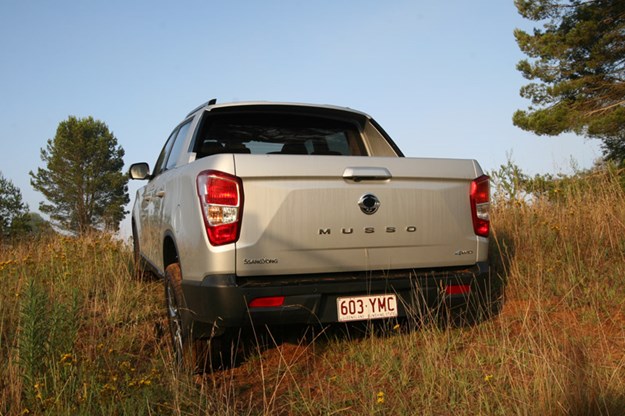 |
On the road
By necessity to meet today’s stringent diesel emissions, the Musso’s engine is a sophisticated and modern diesel with high-pressure common-rail injection and a variable-geometry turbocharger. Despite its modest 2.2-litre capacity and four-cylinder design, and having just one turbo when bi-turbo diesels are becoming more commonplace, the Mussso engine claims a healthy 133kW of power and 400Nm of torque. By way of comparison, the 2.8-litre diesel in Toyota’s Hilux claims 130kW of power and 420Nm (when mated to a manual box).
On the road the Musso lives up to its on-paper power claim, with generally effortless everyday performance and power to overtake when needed. What’s more the engine is notably quiet for a diesel and smooth too. For its part the six-speed automatic is also smooth, refined and reasonably pro-active. It’s an Aisin unit, similar to what’s found in current Hilux and Isuzu D-Max.
The Musso differs from most popular utes by having coil springs rather than leaf springs at the rear, although it still retains a live axle. Along with its separate-chassis (body-on-frame) design that means it’s still essentially a commercial vehicle design and not a passenger-car design.
That said it’s still very car-like to drive although the ride quality from the low-profile tyres on the test car’s 20-inch (50.8cm) wheels isn’t great on bumpy roads. The fact that it’s a ute, so built for some load carrying, means the suspension is firm anyway.
Top-spec models also get speed-sensitive steering but this loads up noticeably in corners at highway speeds. You get used it but it would be interesting to drive a lower-spec variant with the standard steering.
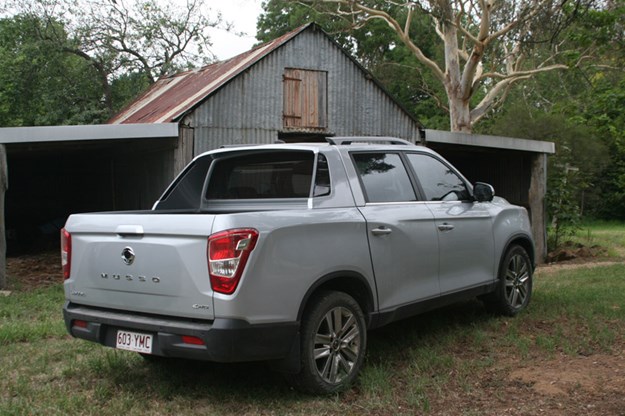 |
In the paddock
The low-profile tyres and 20-inch wheels on this Ultimate model aren’t want you want in the paddock either but lower spec models are fitted down to 17-inch (43cm), which can be swapped onto this top-spec model if you want a more practical wheel and tyre combination.
Otherwise the Musso is pretty straight forward with its driver-activated (rotary dial) part-time 4WD system, complete with dual-range gearing. There’s also a driver-activated rear diff lock, which can help in slippery conditions. A bit more ground clearance would help as the Musso is lower slung than most of the popular utes but taller, more paddock-friendly tyres would help a little here.
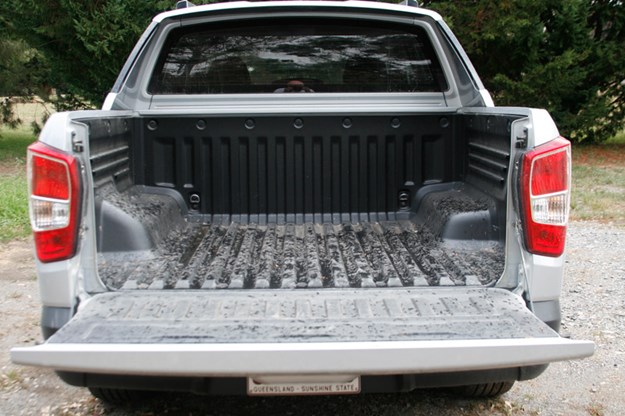 |
|
The tub is 200mm shorter than the popular dual-cab tubs, which are typically 1.5m long, but it is deep
|
Load and tow
Our test Musso wasn’t fitted with a towbar, so we couldn’t do any towing as part of this test. Somewhat surprisingly the Musso claims a maximum tow rating of 3,500kg, so up there with the class leaders. Hopefully we can test out this claim shortly although the up-coming long-wheelbase model (complete with leaf springs at the rear – see ‘Musso muscles up’) would be the better bet for heavy-duty towing.
While the Musso claims a high towing rating, its maximum payload of 790kg is down 150kg to 250kg from most of the popular utes. The tub is also 200mm shorter than the popular dual-cab tubs, which are typically 1.5m long. The Musso tub is however quite deep and will take a European (but not a standard full-size) pallet between its wheelarches. The tub also comes with a liner and four tie-down rings.
 |
|
Inside, the controls are well laid out and easy to access
|
Ownership
Ssangyong’s seven-year, unlimited-kilometre warranty is just what the brand needs to foster buyer confidence. Warranties don’t come any better. And it’s backed by seven-year road-side assistance and seven-year fixed price servicing.
Currently Ssangyong has 36 dealers nationally with plans to expand that to 45 by the end of 2019.
Sum up
It’s a good thing that Ssangyong is back in Australia as the company has always made decent 4WDs, utes and SUVs, especially given the budget asking price. The lack of stable and consistent distribution here has been the problem, not the quality of the vehicles.
For its part, the Musso comes across as more convincing that its Chinese rivals, even if they are cheaper again. The Musso is notably strong on active safety and offers car-like driving demeanour but can still perform ute and 4WD duties.
RELATED ARTICLE
Ssangyong Musso prices*
EX (manual): $30,490
EX (automatic): $32,490
ELX (automatic): $35,990
Ultimate: $39,990
*Prices are drive-away
Ssangyong Musso Ultimate Specs
Engine: 2.2-litre four-cyl turbo diesel
Max power: 133kW @ 4,000rpm
Max torque: 400Nm @ 1,400-2,800rpm
Gearbox: six-speed automatic
4X4 system: dual-range part-time
Construction: separate chassis
Front suspension: independent/coil springs
Rear suspension: live axle/coil springs
Brakes: discs front/discs rear
Wheel/tyre spec: 255/50R20 105H
Unladen weight: 2,090kg
GVM: 2,880kg
Payload: 790kg
Towing capacity: 3,500kg
GCM: 5,980kg
Overall length: 5,095mm
Width (inc. mirrors): 2,175mm
Height: 1,840mm
Wheelbase: 3,100mm
Track (F/R): 1,640mm/1,640mm
Ground clearance: 215mm
Fuel tank capacity: 75 litres
ADR fuel claim: 8.6 litres/100km
Test fuel use: 9.2 litres/100km


